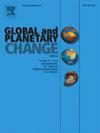Monsoon variability and high latitude climate signals in the Central Mediterranean at the Pliocene- Pleistocene transition: The Gelasian stratotype section (Monte San Nicola, Sicily) [Global and Planetary Change, volume 249, 104788]: Comment
IF 4
1区 地球科学
Q1 GEOGRAPHY, PHYSICAL
引用次数: 0
Abstract
The stratigraphic record of Monte San Nicola (southern Sicily, Italy), where the Global Boundary Stratotype Section and Point (GSSP) for the Gelasian Stage (Lower Pleistocene) has been defined, has been studied by our research group for fifteen years. In 2021, another working group (GELSTRAT) started investigating the Monte San Nicola stratigraphy in a location close to the GSSP section, with results that differ significantly from those published by our team. In particular, major discrepancies in the alkenone-derived paleotemperature reconstructions led the GELSTRAT team to suggest that our age model is invalid, and they inferred that we had made a wrong interpretation of the physical stratigraphic record. In this comment, we demonstrate that our chronological model is correct, while the stratigraphic profile studied by the GELSTRAT team should be approached with care, due to the presence of tectonic displacements, truncations, and uncertain lithological evidence for critical marker beds, such as the sapropel layers below the Nicola bed.
上新世-更新世过渡时期地中海中部季风变率和高纬度气候信号:Gelasian层型剖面(Monte San Nicola, Sicily)[全球与行星变化,卷249,104788]:评论
本课课组对意大利西西里岛南部蒙特圣尼古拉(Monte San Nicola)的地层记录进行了15年的研究,该地区确定了下更新世格拉西亚期的全球边界层型剖面和点(GSSP)。2021年,另一个工作组(GELSTRAT)开始在靠近GSSP剖面的位置调查Monte San Nicola地层学,结果与我们团队发表的结果有很大不同。特别是,烯烃衍生古温度重建的重大差异导致GELSTRAT团队认为我们的年龄模型是无效的,他们推断我们对物理地层记录的解释是错误的。在这篇评论中,我们证明了我们的年代学模型是正确的,而GELSTRAT团队研究的地层剖面应该谨慎处理,因为存在构造位移、截断和不确定的关键标志层的岩性证据,例如尼古拉层下方的冲积层。
本文章由计算机程序翻译,如有差异,请以英文原文为准。
求助全文
约1分钟内获得全文
求助全文
来源期刊

Global and Planetary Change
地学天文-地球科学综合
CiteScore
7.40
自引率
10.30%
发文量
226
审稿时长
63 days
期刊介绍:
The objective of the journal Global and Planetary Change is to provide a multi-disciplinary overview of the processes taking place in the Earth System and involved in planetary change over time. The journal focuses on records of the past and current state of the earth system, and future scenarios , and their link to global environmental change. Regional or process-oriented studies are welcome if they discuss global implications. Topics include, but are not limited to, changes in the dynamics and composition of the atmosphere, oceans and cryosphere, as well as climate change, sea level variation, observations/modelling of Earth processes from deep to (near-)surface and their coupling, global ecology, biogeography and the resilience/thresholds in ecosystems.
Key criteria for the consideration of manuscripts are (a) the relevance for the global scientific community and/or (b) the wider implications for global scale problems, preferably combined with (c) having a significance beyond a single discipline. A clear focus on key processes associated with planetary scale change is strongly encouraged.
Manuscripts can be submitted as either research contributions or as a review article. Every effort should be made towards the presentation of research outcomes in an understandable way for a broad readership.
 求助内容:
求助内容: 应助结果提醒方式:
应助结果提醒方式:


